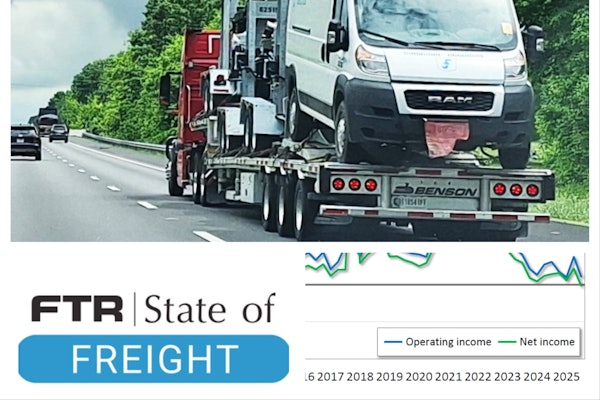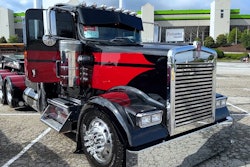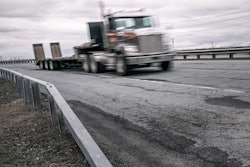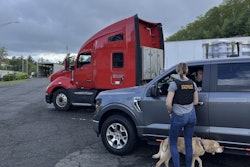Robert Wallace has been hauling Tom Abrams’ race boats for 25 years.
Scarecrow likes to keep ’em guessing.
“When you haul some of the biggest racing powerboats in the world, drivers all over America just have to talk to you,” says Kevin Kahl, whose handle is Scarecrow. “But ever since we turned the boat around on the trailer we’ve been fooling a lot of truckers.”
Recently the No. 12 Flowmaster team repositioned its big Super Cat race boat on its 53-foot trailer so that the bow is at the rear of the trailer and the big engines are at the front, putting them much closer to the workshop built onto the chassis behind the sleeper of the 1994 Kenworth T600 with a Detroit 470. Work on the engines is now extremely efficient, says Kahl.
“When I’m out there driving down the highway, the question I get most from guys out there in the big rigs is ‘Hey, how’d you back that thing on the trailer?’ We have a lot of fun with that.”
American Power Boat Association offshore racing Super Cat boats, as a group the biggest, most powerful racing boats in the world, don’t go into the water like your bass boat when it’s behind a pickup truck. They’re so big that cranes are needed at race venues to get them in and out of the water using special linkages built into the hull. And that might happen three, four or five times in the days leading up to the race, meaning a lot of tight maneuvering and pinpoint backing for the drivers of the big tractors that haul some of the premier boats in this sport.

Once the boats are in the water, spectators can watch some of the most spine-tingling excitement in the world of racing. The current trend in offshore races, such as the recent APBA Offshore event in Marathon, in the heart of the Florida Keys, is to race closer to shore in hopes of attracting racing fans like those that flock to NASCAR events.
Watch these 40-foot, closed-canopy monsters that can weigh 9,000 pounds and use twin 750 horsepower engines, and you’ll see the rough and tumble, the bumping, the tension, the breath-holding passing maneuvers and thrilling strategic battles at 140 miles an hour on water that pounds and bounces the boats.
The biggest of the boats commonly use Class 8 tractors to haul them. The smaller boats rely more on big pickups with powerful diesels and duallies.
While turning the Flowmaster around didn’t make much difference to the boat’s hauling characteristics (“She’s a pretty easy load,” Kahl says.), it has posed a few new challenges for Kahl, a former trucker who drove OTR for more than a million miles over 10 years, the last three of them hauling steel for a New York company. He left the road to build custom motorcycles in Clearwater, Fla.
“Used to be I could see the boat clearly when I was rolling,” says Kahl. “Now I can see nothing of it except a corner of the stern. I can’t see a thing down the side of the boat. When we turned the boat around we also raised the trailer mounting 6 inches so she’d go over guard rails or concrete retaining walls if we got too close in turns of parking lots. And she’s now also high enough that cars that come too close would hit the trailer and not the boat.”
Kahl says the team is also considering making a change that others in the sport have already done – changing from a tractor to an RV. “Why pay taxes when we’re not hauling freight?” he says. “There’s no revenue generated by the truck and the trailer. And as an RV we can travel more freely, without a load of permits and restrictions.”
Robert Wallace hauls race boats with a truly classic working truck – a 1986 long-nose Peterbilt 359 with a 425 horsepower 3406 Caterpillar engine, a 372-inch wheelbase and a 180-inch sleeper. Wallace has been driving big rigs for 25 years and hauling race boats for Reliable Carriers of Canton, Mich., for about as long. These days he’s special events driver for the company, and his rig sports a transmission only a true driver could love, what Wallace calls “a six and a four,” 24 gears, two gear shifts – one for high, one for low – and a full clutch. A Reliable Carriers’ Kenworth W900 also goes along to the boat races pulling a state-of-the-art workshop on wheels in a 53-foot van.
Tom Abrams is the owner of Reliable Carriers, a 35-year-old company with a fleet of 350 rigs that is the nation’s largest specialized hauler of special vehicles from concept cars, prototypes and classics (including a contract to deliver the newest Rolls Royce models to their dealerships), especially to auto shows. He’s also owner/driver of a boat of the same name, the one Wallace hauls around the country.
“Tom was driving when I met him. I had a friend who told me I’d hit it off with Tom, and so we met in a bar, and we did. We’ve been friends for about 25 years now,” Wallace says. “We started out back then driving team, and he taught me a lot. There were only about five trucks in the fleet then, and we were doing household and some cars. Tom’s dad had started the company, and after about seven years, Tom went into the office. I stayed on the road.”
And when Tom Abrams bought his first racing boat, an 18-footer, in the 1970s, Robert Wallace pulled it.
“It was a flat-bottomed thing, and man would it shake you around out on the water,” Wallace says. “We raced that boat in poker runs, going from marina to marina out on the [Great] Lakes or around the Thousand Islands in Michigan. Tom kept getting bigger and better boats, and we kept racing poker runs.”
When Wallace would pull up with the boat in tow, he always got a reaction, Abrams says. “Robert would drive in with the boat on a trailer, and, man, did he turn some heads,” Abrams says. “It had a huge impact because no one else used big tractors.”
The pair kept racing, and they kept getting better. In 2001 Abrams piloted a 46-foot boat Wallace had hauled to New York City down the Hudson River at 170 miles per hour, a record for the run, and won the King of the Hudson race.
The boat Wallace pulls today has a gross weight of nearly 10,000 pounds, and the Pete is pulling about 30,000 pounds. But the boat just squeezes under the 12-foot mark in width, so no escort is needed on the road.
“The boat is not hard to pull. It sounds simple, but all you really have to do is keep it between the white lines. When I first started pulling race boats, I was really very nervous. It was new to me, and the permits and scales and hours and all sort of new things to worry about. I learned very quickly that you have to pay attention to what’s back there. But once I got used to it, it was really smooth sailing most of the time,” says Wallace.
With the company’s backup Kenworth W900 subbing for the old Pete, the Reliable Carriers’ No. 20 Super Cat is lifted off its trailer by a crane for launching at the 33rd Street Pier in Marathon, Fla.
“The trailer axles are underneath the boat, so if I need to I can roll with some of the boat riding out over the shoulder and the trailer wheels still on the road, not on the loose metal of the shoulder.”
Truckers rarely miss a chance to call a race boat hauler on the CB or come up to a parked truck. Comments like “take that right to my garage” or “meet me at the boat ramp and we’ll go fishing” are everyday occurrences. And in the South, says Wallace, more and more truckers refer to the racers as “real big bass boats.”
And of course there are endless questions about how drivers can possibly back the boat down a ramp and into the water. “We couldn’t use a ramp if we wanted to; the Super Cat’s too heavy to float off the trailer even if we could find a big enough, deep enough ramp,” says Wallace.
While wives don’t generally flock to the races (“It’s a lot of hot, hard work with engines and boats,” says Wallace, “not really very glamorous or fun for a lot of them.”), Wallace often takes wife Annette and daughter Kirsten, 14, along for the ride. At the Marathon race he managed to sneak some time off and take them as far south as you can go in America, Key West, and gave them a tour of the famous little island, “complete with some truly bizarre sights.”
Abrams is a fourth-generation trucker. “I drove for seven years. That was my first real job, it was all I knew how to do,” says Abrams. “Driving was what I did, but then I had to move into the front office. It was really hard making that move; I was a driver.”
Abrams says Reliable Carriers benefits from what he learned in those years on the road. “I still think like that; I’m a hands-on manager, and I’m always available to my drivers. We have some of the best drivers you’ll find anywhere. We’ve never had a driver shortage.”
Abrams admits that the one time he drove the classic old Pete that hauls his boat, he ran into a little trouble. “That two-stick transmission can take some getting used to. I got it stuck in gear, rolling down a highway at 1,600 revs doing about 45 miles an hour. I had to call Robert, and he came out with a hammer and banged away at it to free the linkage.”
The big, twin-hulled Super Cats carry two men, one behind the wheel, the other handling the throttles. The throttle man on the Reliable Carriers boat is Jerry Gilbreath. “Here’s a guy,” says Abrams, “who has won eight World Championships. He’s the best setup man in the business, and now he’s teaching me. Wow.”
Gilbreath says that in the years before he joined Abrams he managed transportation for his own teams, including getting all the required permits. “I made sure of every piece of paper. I’ve been racing boats for 40 years and not always with this level of success, not always with the great equipment his team has. But I never liked to ask anyone to do something as part of the team that I hadn’t done or wouldn’t do. And I still keep up my CDL. My wife and I drove a Kenworth T600 around Europe two years ago pulling a race boat,” Gilbreath says.
“My idea of the best way to manage is to have been there and done everything. I’ve changed wheel bearings on trucks; I’ve had a truck break down on the side of the road and had to find a way to fix it and keep going.”
Alan Ritz and Jim Shimandle handle a matched set of 2002 Freightliner Argosy COEs with Detroit Series 60 500s and Fuller 10-speed shifts. Behind one of the tractors comes the No. 84 Platinum boat on a 40-foot Bollini custom trailer built in Italy. Loaded up, the tractor and the trailered boat weigh about 66,000 pounds. The other tractor pulls a support trailer for the team, KR racing, which is owned in Norway.
“We usually race both here and in Europe,” says Ritz, “maybe with four or five races here, 10 over there through the summer. The shorter wheelbase is really useful in some of those tight places you can find yourself in older European cities. But this year, things being the way they are, we’ll concentrate our racing here.”
The team’s former hauling power came from Kenworth T600s, but the longer truck made some maneuvering difficult in tight European quarters. The shorter COEs are also helpful on the roll-on/roll-off ships that carry the tractors – and the boat – back and forth across the Atlantic. And their size is also valuable if they have to be shipped by air to meet tight race deadlines, says Ritz.
The KR Racing trailer tilts, although not enough to bring the boat back under oversized limits. Instead of an 11-foot, 9-inch load, the KR tractors pull a 10-foot 9-inch load. “She’s still wider that regulation,” says Ritz, “but we can see around her more easily, there aren’t any blind spots and we don’t need extension mirrors. But we also have a bigger boat; she’s over 12 feet wide, and when the trailer tilts, the load comes under 12 feet. So we don’t need escorts when we haul her to races.”
The hardest part of the haul, says Shimandle, “is people pulling up next to you and staying right there beside the boat. It makes it hard to move, and you can never take your eye off them. We had some teenagers in Ohio who just wouldn’t leave us. They stayed with us for a long time; they wouldn’t let us change lanes.”
All of the drivers help out with racing teams. Since there are no pit stops during an offshore power boat race, most do their additional work when the boat is sitting on the trailer. Some work on engines, some just help clean the boats. There are no crews that have the luxury of a driver who just drives a Class 8 tractor.
Typically, drivers spend 10 days getting ready for, getting to, working and getting back from races. Many tractors and their cargo are left behind if races are not far away, the crews going home by air and picking the truck up and moving to the next race. For example, California-based teams leave their boats on the east coast when they go back home between races.
Ralph Zell is an independent owner-operator who hauls cars from his base near Daytona, Fla. He also drives the Peterbilt 386 that hauls the Callan Marine boat on a 55-foot trailer. “I mainly drive from car dealers to auctions and back. This boat racing, this is a hobby. The people who own this boat are friends of mine, and they asked me if I’d like to drive it to races. It was a wonderful opportunity to be a part of a big, exciting operation. I love boats, but I couldn’t afford to get close to this. Hell, I’d pay them to do it.
“I try to do a lot of little things when we’re at races,” says Zell. “Sometimes that’s washing the boat, sometimes it’s just have the truck ready to roll when they want to roll. And I take care of permits and the other paperwork that comes with the truck. The owners didn’t want to have to do that – it’s not part of making the boat win – so that’s an area where I can take a load off them.”
Randy Linebach, who builds really big boats – over 50-feet long – for a living, owns and drives the 24 Airborne/Big Thunder Super Cat. He also drives a Kenworth T600 that he bought from Ryder, where it had been in the business of hauling furniture.
“We used to haul the boat with a small truck with duallies, but it really wasn’t big enough. I’ll tell you this, driving the big truck is still a lot more relaxing that driving that boat at 140 miles an hour,” he says, laughing.
So why drive the boat? “It’s the adrenaline. I think that’s why we all do it. But it beats you up pretty good out there. Get some rough water, and you come ashore black and blue. The Kenworth, on the other hand, leaves you feeling really fresh even after a 700-mile run,” says Linebach.
Glen Dalton from Santa Barbara, Calif., pulls the 45-foot Super Cat No. 139, the How Sweet It Is, which also sits on a tilt trailer. “When you look in your side mirror and pretty much all you see is road, it’s a lot easier to drive that when you have the boat sitting flat on a trailer. And there’s a lot less worry that the side of the boat will get hit.”
John Meiser drives the Kenworth T600 that hauls the No. 31 Page Racing boat Patriot, and when a turbine needs to be changed the day before the Marathon race, he disappears into the engine wells and is part of the mechanical crew. When the boat is ready for testing, he drives the Kenworth to the 33rd Street dock and waits in line.
“This is slow, and it’s really tight for a big truck. A lot of races you just drive under the crane and when the boat is lifted off, you can drive away. But today it’s wait, wait, and the crowded little dock requires some tight maneuvering and waiting while one boat goes in and its truck moves away.
“Sometimes I think a smaller truck would make things easier. But with this one, while we wait we’ve got an air-conditioned sleeper and an air-conditioned workshop.”
The complete package. Wes Gilmore and the Dirty Duck, loaded and ready to roll.
The Disappearing Duck
A hydraulically tilting trailer narrows a wide boatload
Watch Wes Gilmore in oncoming freeway traffic, and you’d think his Freightliner was hauling nothing more than a regular load. Maybe a flatbed or a van. Even a reefer. But few suspect there is an offshore racing powerboat in tow behind the tractor. The Dirty Duck, a Super Cat Light entry in the APBA offshore racing series, is 10 feet 6 inches wide, 39 feet long, powered by two 525 horsepower Mercury engines and weighs in at 8,000 pounds, but you can’t see her as the Freightliner drives towards you.
“She’s 10’6″ until we tilt her. Then she’s 8’6″,” says Gilmore.” Driving with the boat tilted really isn’t very difficult. You can’t see the boat, but that’s not really a problem. I’ve had truckers ask me if the wind affects the boat when it’s up and tilted, but it really doesn’t affect the handling unless it’s a really strong wind, and we can wait those out.”
Fewer onlookers suspect that the Freightliner is not even a tractor – it’s officially a recreational vehicle.
“We’re not a wide load, and we’re not over height, so we can move about a lot more freely and without all those permits. And when someone stops us in an official capacity, they’re usually surprised to find we are registered as a recreational vehicle, and we can drive a lot of places and times commercial tractors and trailers can’t. We’ve got a generator and everything else you need to be an RV. And why not? That’s what we are; this isn’t a trucking business, this is recreational adventure.”
The Dirty Duck races in the colors of Hefner Furniture and Accessories, and she’s driven by company owner Slug Hefner. The same company hauls another boat to races inside a dry van. That would be a pro-modified drag boat that will go from zero to 170 miles an hour in seven seconds.
In the Marathon race the Dirty Duck showed a clean pair of webbed feet to the field and won the Super Cat light division.







